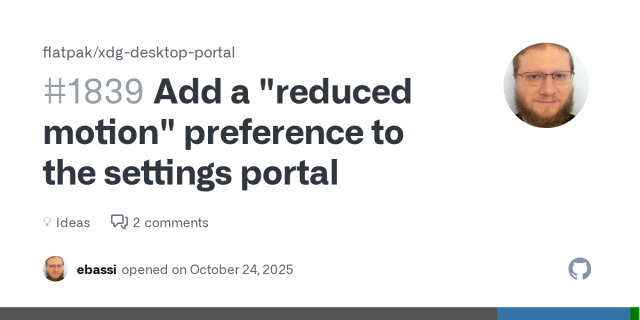RE: mastodon.social/@ebassi/115429…
Got nerdsniped around lunchtime yesterday, and ended up implementing a shared "reduced motion" setting for GNOME and the rest of the xdg stack:
- gitlab.gnome.org/GNOME/gtk/-/m…
- gitlab.gnome.org/GNOME/gsettin…
- github.com/flatpak/xdg-desktop…
- gitlab.gnome.org/GNOME/xdg-des…
- gitlab.gnome.org/GNOME/gnome-c…
#a11y #accessibility #gnome #gtk #xdg #portals

Add a "reduced motion" preference to the settings portal · flatpak xdg-desktop-portal · Discussion #1839
Under GNOME we're currently abusing the boolean "enable animations" toggle, but this poorly maps to the actual accessibility issue of reduced motion. Ideally, we want to map to the same kind of set...GitHub

Emmanuele Bassi
in reply to Emmanuele Bassi • • •Emmanuele Bassi
in reply to Emmanuele Bassi • • •Gary "grim" Kramlich
in reply to Emmanuele Bassi • • •Emmanuele Bassi
in reply to Gary "grim" Kramlich • • •Gary "grim" Kramlich
in reply to Emmanuele Bassi • • •jntesteves
in reply to Emmanuele Bassi • • •Emmanuele Bassi
in reply to jntesteves • • •Danielle Foré
in reply to Emmanuele Bassi • • •Børge
in reply to Emmanuele Bassi • • •